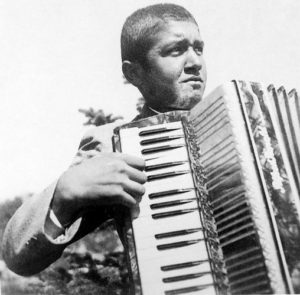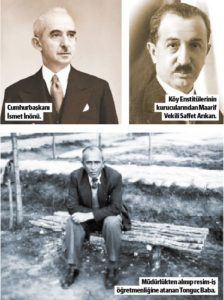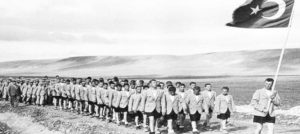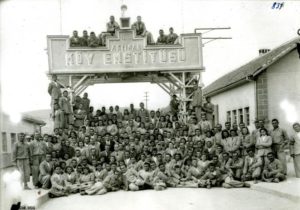TERMPAPER SUBMITTED TO THE COURSE “TURKISH POLITICAL STRUCTURE”, DR IBRAHIM SAYLAN, FACULTY OF BUSINESS, DEPARTMENT OF INTERNATIONAL RELATIONS, DOKUZ EYLÜL UNIVERSITY, IZMIR.

Abstract:
This paper will discuss and evaluate the Village Institutes experience in Turkey. This Paper begins by analyzing the historical context of the period and moves on the evaluation of the general characteristics of Village Institutes. In the part of the general characteristic, I have tried to observe both sides’ views (peasants and governors) equally. This part also include the specific features of İsmail Hakkı Tonguç, and generally try to explain why and how does village institutes maintain itself enough to go on with. Finally, I will try to explain the story of closure process and evaluate the outcome and process assessment.

Introduction
I would like to start with the explanation of why I have decided to focus on the village institutes. Village institutes, as i will explain later, directly related with the education. And as we all know, education has been the most important debate in all stages of society. Education has always been the center of attraction to all governors, especially law makers. When we look at the difference between third world countries and developed countries, we can easily observed the difference between the importance of education. We can clarify this argument quate from Benedict Anderson. According to Anderson, Martin Luther had significant change in his era because he was printed up in German translation, in this way, ‘We have here for the first time a truly mass readership and a popular literature within everybody’s reach.’ said Martin Luther. With this example, we can see the impact of the language in world history. With print capitalism, language and printed source have spread all over the world, and with some systematic educational program (also there are many other factors that affect this outcome), level of wealth and the position of the states in world society had changed rapidly.
Just like in the print capitalism, education should be spread all over the country, if we want to change the dynamics of the society and state also. Like Nelson Mandela said; Education is the most powerful weapon which you can use to change the world.
Village institutes are the exact proper example for diffusion of the knowledge. Village institutes have a significant and special place of educating teachers in Turkish history. Also these institutes have tried to educate village children, by this way the institutes are the lead thefield of social development. These institutions also tried to develop the rural Turkey. According to Asım Karaömerlioğlu, “Some of them were to modernize the social relations, to bring an end to poverty and ignorance among the peasants, to create peasants intellectuals, to increase agricultural productivity and to help spread the Kemalist Revolution in the countryside.”(1) Graduates of these Institutes were educated to guide peasants in agricultural and technological matters.(2) The village institutes provided rural Anatolian boys and girls a five year secondary educational program in a boarding school, where they received a complete education and learned skill, such as carpentry or wifery.(3) After that education, those students go out the other villages in Turkey, and they had tried to transfer the information that they had learnt. But besides all these, Village Institutes was criticized by some of the important intelligentsia. For instance, Kemal Tahir, one of the famous Turkish novelist said that the village institutes being fascistic institutions by which the single party regime aimed to spread its ideology.

Historical Context Before starting the details about village institutes, i will give a historical background of the village institutes. These institutes had been active between 1940 and 1954. Prime Minister İsmet İnönü had leaded this Project and with the contributions of the Minister of Education (Hasan Ali Yücel) and İsmail Hakkı Tonguç Villagi Institutes opened in 1940.
Many Scholars has mentioned that the important role of the İsmail Hakkı Tonguç in the process of Village Institutes. What depicts Tonguç, for instance, to some as a “pure Jacobin,” a “peasantist ideologue” or a “believer of Kemalism” whereas to others as a “revolutionary in the field of education” or the “Ataturk of education” is the ideologies adopted by the commentator; just like some regard Village Institutes as the “Trojan Horse of Kemalism in the village”(4). But the Village Institutes did not remain as a Jacobin social engineering project theyevolved into a “social movement” which included educational, social and cultural aspects.(5) The Village Institutes meant for Tonguç more than an educational institution, let alone being an institution training teachers for the village. That the Institutes are not institutions that merely train teachers for the village is resolved in the 1st article of Village Institutes Act: “The Village Institutes are established by the Ministry of Education in places where there is arable land in order to train teachers and other profession experts.”(6)
One of the political characteristics of Turkish Republic for educating teachers is that it had preferred to educate them in two ways till 1953. Till that time, the institutions for educating teachers for cities and villages had been separate.(7) This type of separation creates a differentiation in the whole education system because teachers who had their education in cities did not want to work in villages.
Actually we must go back in the history. In the First Izmir Congress of Economics (between 17 February – 4 March 1923) the farmers who participate had importance in many ways. The farmers, who were aware of the fact that education was very important for a developing society, highlighted the importance of an applied modern education with little funds.(8) The changing Turkish context necessitated directing attention to villages and villagers. The The village institutes literacy campaign was unique because of its focus on the education of villagers and its aspiration to relate education to the daily lives of villagers. Concentrating on educating the countryside, this campaign produced a class of educated peasantry who served as village teachers, educators, writers/poets, public health officials and community leaders among others.(9)

The Kemalist education policy was set out in 1927 in an address by the Minister of National Education, Mustafa Necati, Who described the programme”s aims. It said: All citizens must be entitled to a national democratic, modern end secular education. The literacy campaign conducted from 1928 onwards played a very important part in the creation of a secular State. In 1927, when the total population stood at around 13.5 million, over 89% could neither read nor write. In villages, the proportion of illiterates was 94%. Nearly 30,000 of Turkey’s 35,000
villages had no school. (10) Now, for sake the newly established Republic of Turkey, problem of education had to be solved. Because, as I said in the beginning of the paper, Education createsa spill over effect, which means, it also affects the other important areas in the state.
After that situation, one specific question was asked by the governors. Where were the necessary resources to be found to build schools, pay teachers and set up teacher-training centers?
What was the plan? Ismail Hakki Tonguç, the director general of primary education, and his colleagues designed a plan. The plan called for creating special teacher-training institutes, recruiting village students to them, teaching these students general subjects plus useful village technology, and then sending them back to the villages to teach in five-year primary schools.
General Characteristics of Village Institutes
Turkish Village Institutes (TVI) was a multi-dimensional and multi-purpose project. First and foremost, TVI promised to educate village youth in the secular values of the Turkish nation. (11) Secular education should be understood to imply that education should be free from all kinds of religious influence and superstitions.(12) It was not just a theory and practice, where students not only had the classical lessons like literature, math and science, but a heavy load of practical ones like agriculture, construction and farming, skills necessary for village life. The idea was for the teachers to be able to sustain the whole system, including building the schools.(13)
The Ministry of Education intentionally located the institutes in rural areas, so that students could practice farming, plant orchards, develop water and sanitation systems, and generally confront typical village problems with modern skills and science.(14) Children trained in VillageInstitutes were tried to be emancipated from the scholastic. Their culture is not the knowledge memorized; it is the general and pure knowledge learned through work at work.(15) Youths of both sexes, between the ages of twelve and sixteen, who were graduated by a five-year village primary school, qualified for admission to a village institute. The government offered this education free to students who pledged to teach in an assigned village for twenty years after graduation.(16)
The curriculum of the Village Institutes took into consideration, and was responsive to, the local conditions and needs; emphasis was placed on the unity of general and vocational knowledge in their curriculum.(17) Fifty percent of the institutes’ curriculum was devoted to “culture classes.”(18) The remaining fifty percent was divided into two. While twenty-five percent of the curriculum was reserved for agriculture classes, the remaining twenty-five consisted of technical classes.(19) Each institute had autonomy in defining their weekly, monthly, yearly programs in accordance to their needs.(20) The institutes were established in villages because an overwhelming majority of the population (more than 80 %) was, at that time, living in the villages.(21) Second, the city had no real connection with the realities of the country, and the city schools, according to Tonguc, did not overlap with the realities of life.
Third, the village life, Tonguc argued, comprised the elements of the true community life- of mutual help and friendly cooperation.22 The institutes were to be built upon, and make use of, these traditional collaborative relations called “imece.”(23)
There were also economic expectations from the TVI literacy campaign. These included a desire for improved production techniques in the countryside and development in agriculture.(24) Actually, in my opinion, besides all of the efforts on the social and cultural changes, it also had tried to get success in the field of economy in the long run. Also after the creation of strong and independent peasants, state could prevent the migration from village to urban cities. Since 80% of the population resided in the countryside, a possible migration to the cities frightened the urbanites.(25)
When we look at the side of villagers, at the beginning, they expressed some resistance to the Village Institutes. There are lots of reasons behind this resistance. For instance, some scholars believe that the peasants who lived in villages did not want to support the institutes because they actually don’t believe in the sufficiency of the resources which is provided by government. Also the rich villagers did not always support the village institutes because they had feared to lose their power in the certain area. Literacy seemed like a dangerous for them because knowledge is used as a weapon for both individual and social rights by poor villagers.It depends on the outcome actually. If there is a benefit after the process, then aghast in the villages had supported the idea of institutes and gave support for them. But if there was threat,then, aghas were avoiding it. One other source of opposition to TVI came about because of party politics.(26) The transition period has a irregular features in itself in many areas. Because at that time, after the second World War, like many other countries, Turkey started to change deeply its political views. First time in the Turkish History, USA and Turkey got in a bilateral relation with each other. The reason behind this convergence is the fear that came from the Soviet Union. When we look at the elections”46, elections leave the Hasan Ali Yücel and Tonguç out of squad.The natural causes of those events is the losing attention to the village instates. At that tame, teachers who are worked in village institutes were forced to give back tha equipment that theyhave. Teachers were in a stuck in a difficult situation and they did not their duty in a proper way anymore. After the regulations which are implemented by the new government, teachers became hourly paid workers. The newly-founded Democratic Party (DP) opposed TVI strongly because of their rivalry with the Republican People’s Party (RPP) – the governing party at the time. TVI was formed during the RPP era and was fully supported by the RPP government, which was why the DP took such a strong position against it.(27) Democrat party had always manipulated the village institutes with using moral sense of values in the villages. For instance, in the village institutes, girls and boys were educate in the same class and it is highly controversial subject in the villages and Democrat party used this sensibility over the villages during the smear campaign to village institutes. Those campaigns had worked in some ways actually. Villagers slowly started to feel less passionate about the TVI literacy campaign.(28)
After that circumstances, surprisingly, Republican People’s Party had decided to close the village institutes. But what was the reason behind it? At the end of the process, Republican People’s Party had invested this project a lot. But when the subject came to the race in elections, Republican People’s Party had decided to change its campaign in an opposite way. We can clearly say, Republican People’s Party pull the rug from village institutes with the concern of vote. However, the RPP still lost their place to the DP in the elections (1950). After 1946, various political attacks directed at TVI, weakened the TVI campaign and broughtit to an end.(29) Democrat Party transformed Village Institutes into regular village schools.
Conclusion
The Village Institutes were to cultivate, in the words of Gramsci, “organic intellectuals” and, in the words of Tonguç, individuals who can “overcome their destinies,” If the major responsibility of intellectuals is, as Bourdieu (2006, p. 114) states, “contributing to the creation of social conditions for collectively producing realistic utopias,” Tonguç successfully fulfilled this task.(30) The institutes provided some of the most idealistic and dedicated rural teachers in Turkey’s history. These young men and women inspired many villagers to continuetheir educations beyond primary school; some even went to the university.(31) The village institutes could hopefully fill the gap between the peasants and the elite by creating elites from amongst the peasants.(32) This approach could make easier to accomplish the peasants needs in their economic and social life. It had created a skill by the method of “learning by doing”.
Even though TVI was closed down in an untimely fashion and its existence was short-lived, its influence was long-lived in the countryside and in the nation at large.(33)
References
Zabıtgil, Özlem, (2010) The Poetry Of Turkısh Vıllage Instıtute-Educated Poets: Socıal Commentary On A Developıng Natıon p. 38
Stone, F. A. (1973). The evolution of contemporary Turkish educational thought. History of Education Quarterly, 13(2), 145-161.
Seçkin Özsoy, A Utopian Educator from Turkey: İsmail Hakkı Tonguç (1893-1960), Journal for Critical Education Policy Studies, vol.7. no.2 p. 261
Karaomerlioglu, M.A., (1998a). The Village Institutes experience in Turkey. British Journal of Middle Eastern Studies, 25(1), 47-73.
Kirby-Berkes, F. (1960). The Village Institute movement of Turkey: An educational mobilization for social change. D.Ed. Dissertation. Teacher’s College, Columbia University, NY.
Vexliard, Alexandre, and Aytac, Kemal. “The Village Institutes in Turkey.” Comparative Education Review 8 (1964): 41 – 47.
Arslan, Hakan & Özü, O. Village Institutes from Past to Present Day and Ascertainment towards Future. International Conference: The Future of Education. p. 2.
Ozelli, M. T. (1974). The evolution of the formal educational system and its relation to economic growth policies in the first Turkish republic. International Journal of Middle East Studies, 5(1), 77-92.
Arayici, A. 1987. Village institutes in Turkey (1937–52). Paris, PUF, p. 61–63; 169–76.
Arayici, A. 1999. Village institutes in Turkey. Prospects. XXIX (2), 267-280.
Korur, A. F. (2002). Democratic education, the village institutes system in Turkey and its art education component. Ph.D. Thesis. Ohio State University, Colombus, OH.
Filiz Meseci Giorgetti, (2009) “Training village children as village teachers for village work: the Turkish village institutes”, History of Education Review, Vol. 38 Iss: 2, pp.43 – 55
Dougles Arthur Howard, (2001) “The history of Turkey” p.107
Emrah Güler – Ankara – Hürriyet Daily News – December/23/2013
Footnotes
1 Karaomerlioglu, A. The Village Institutes Experience in Turkey. British Journal of Middle Eastern Studies (1998), 25(1), p. 47.
2 Filiz Meseci Giorgetti, (2009) “Training village children as village teachers for village work: the Turkish village institutes”, History of Education Review, Vol. 38 Iss: 2, pp.43 – 55
3 Dougles Arthur Howard, (2001) “The history of Turkey” p.107
4 Seçkin Özsoy, A Utopian Educator from Turkey: İsmail Hakkı Tonguç (1893-1960), Journal for Critical Education Policy Studies, vol.7. no.2 p. 261
5 Kırby, F. (2000). Türkiye’de Köy Enstitüleri (2nd ed.). (Ed. E. Tonguç). Ankara: İmece Yayınları. (Original work published 1962).
6 Seçkin Özsoy, A Utopian Educator from Turkey: İsmail Hakkı Tonguç (1893-1960), Journal for Critical Education Policy Studies, vol.7. no.2 p. 265
7 Arslan, Hakan & Özü, O. Village Institutes from Past to Present Day and Ascertainment towards Future. International Conference: The Future of Education. p. 2.
8 Arslan, Hakan & Özü, O. Village Institutes from Past to Present Day and Ascertainment towards Future. International Conference: The Future of Education. p. 2.
9 Zabıtgil, Özlem, (2010) The Poetry Of Turkısh Vıllage Instıtute-Educated Poets: Social Commentary On A Developıng Nation.
10 Arayici, A. 1987. Village institutes in Turkey (1937–52). Paris, PUF, p. 61–63; 169–76.
11 Korur, A. F. (2002). Democratic education, the village institutes system in Turkey and its art education component. Ph.D. Thesis. Ohio State University, Colombus, OH.
12 Arayici, A. (1999). Village institutes in Turkey. Prospects. XXIX (2), 267-280.
13 Emrah Güler – Ankara – Hürriyet Daily News – December/23/2013
14 Stone, Frank A. “Rural Revitalization and the Village Institutes in Turkey: Sponsors and Critics.” Comparative Education Review 18 (1974): 419 – 429.
15 Seçkin Özsoy, A Utopian Educator from Turkey: İsmail Hakkı Tonguç (1893-1960), Journal for Critical Education Policy Studies, vol.7. no.2 p. 27016 Ibid.
16 İbid.
17 Ibid.
18 Ibid.
19 Ibid.
20 Ibid.7
21 Seçkin Özsoy, A Utopian Educator from Turkey: İsmail Hakkı Tonguç (1893-1960), Journal for Critical Education Policy Studies, vol.7. no.2 p. 270
22 Ibid.
23 Seçkin Özsoy, A Utopian Educator from Turkey: İsmail Hakkı Tonguç (1893-1960), Journal for Critical Education Policy Studies, vol.7. no.2 p. 275
24 Ozelli, M. T. (1974). The evolution of the formal educational system and its relation to economic growth policies in the first Turkish republic. International Journal of Middle East Studies, 5(1), 77-92.
25 Stone, F.A. (1974). Rural revitalization and the village institutes in Turkey: Sponsors and critics. Comparative Education Review, 18(3), 419-429.
26 Zabıtgil, Özlem, (2010) The Poetry Of Turkısh Vıllage Instıtute-Educated Poets: Socıal Commentary On A Developıng Natıon p. 37.
27 Ibid.
28 Ibid.
29 Stone, F. A. (1973). The evolution of contemporary Turkish educational thought. History of Education Quarterly, 13(2), 145-161.
30 Seçkin Özsoy, A Utopian Educator from Turkey: İsmail Hakkı Tonguç (1893-1960), Journal for Critical Education Policy Studies, vol.7. no.2 p. 272
31 Vexliard, Alexandre, and Aytac, Kemal. “The Village Institutes in Turkey.” Comparative Education Review 8 (1964): 41 – 47.
32 Karaomerlioglu, A. The Village Institutes Experience in Turkey. British Journal of Middle Eastern Studies (1998), 25(1), p. 59.10
Even though TVI was closed down in an untimely fashion and its existence was short-lived, its influence was long-lived in the countryside and in the nation at large.
33 Zabıtgil, Özlem, (2010) The Poetry Of Turkısh Vıllage Instıtute-Educated Poets: Socıal Commentary On A Developıng Natıon p. 38